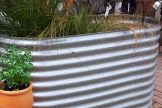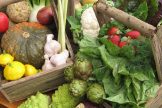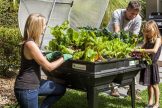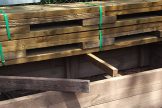
Autumn is the best time to plant your winter vegetable garden. As the weather cools and the rain starts to fall more frequently it is a pleasure to get back into the garden, remove spent summer crops and plant vegetables such as cabbage, broccoli, broad beans and peas. It is an advantage to start planting at the beginning of autumn as many winter vegetables require a long growing period. Read on for everything you need to do to ensure a bumper winter vegie crop.
Goodbye Summer
Pull out what remains of your summer vegies. If the tomatoes are still green, make them into pickles and chutneys or hang the whole bush, roots and all, upside down in a sheltered spot outside. The tomatoes will gradually ripen.
Gather all of the stalks and remains and make a compost heap or chop up as finely as you can be bothered and add them to your compost bin. Avoid composting diseased plants and, if you have chooks, allow them to pick over the beds, removing weeds and any pests. Remember to rotate your crops if you have the room, avoiding planting the same groups of plants in the same spot year after year. This will help prevent disease build up in the soil.
Rejuvenating Soils
Winter vegies need a rich and nourishing soil. Replenish the soil by adding animal manures and plenty of compost and lightly rake it through. Winter vegetables do well with cow manure and dolomite lime added, as well as a layer of pea straw, lucerne or sugar cane mulch on the surface.
Position
Winter vegetables require at least four to six hours of sun a day. If you have to compromise on this then try and put the most leafy plants such as lettuce, silverbeet and coriander in the more shady part of your vegetable patch. If there is an area that simply does not get enough direct sun then try growing a green manure crop instead of letting it lie fallow.
Green Manure
Green manure crops are legumes that are grown to add nitrogen and organic matter to the soil. You can buy bags of green manure seed in nurseries. Sow heavily in well composted soil and allow them to grow until about knee high. Do not allow the plants to flower or produce a crop. Once they have reached your knees then they can be slashed and dug back into the soil. All the nitrogen contained in the roots and foliage will then be released into the soil. Wait a few weeks for the stalks and leaves to break down before planting.

Seeds or Seedlings?
Seeds offer a much wider range of vegetable varieties and are of course much cheaper. Whether you grow from seed or seedlings depends on what you want to grow and how much time you have. If it is late in the season then it probably best to plant seedlings directly into the ground. Some things, such as broad beans, should always be sown directly as seed. Seeds for slow growing vegetables such as cabbages need to sown towards the end of summer and planted out during early autumn.
Pest Control
The cooler weather means fewer pests but they are still about. The most destructive pest at this time of year is the Cabbage White Butterfly caterpillars, known to chomp their way through cabbage leaves overnight, leaving only a stalk behind, as well as slugs and snails. Grey aphids can also make their presence felt. With all of these pests, try manual measures to remove them, such as squashing them, or creating a physical barrier around the seedlings, rather than reaching for the chemical alternatives. Always use a low-impact pesticide or make your own. For caterpillars the best products are Dipel and Success. These low toxicity products will target only caterpillars, without harming beneficial insects.
Watering
Vegetables have a high water requirement and it is important to ensure you have good soil, high in organic matter and moisture retentive, as the basis of your watering system. Do not allow vegetable crops to dry out during the germination and seedling stage, and then ensure that the soil remains moist, but not wet, throughout the growing period. Use a straw mulch to keep moisture in the soil, add organic matter and suppress weeds.
Fertilising
Following thorough soil preparation with manure and compost, a liquid fertiliser is the only ongoing fertiliser you will need to add as your vegetables grow. Commercial options include seaweed and fish concentrates, or you can easily make your own at home using manure, worm castings or weeds pulled from the garden. An easy method is to place manure in hessian bag, soak in a bucket for about two weeks and dilute to the colour of weak tea for fortnightly applications.
Flowers
A spot of colour throughout the garden is always welcome, especially through winter. Brighten up your vegie patch with seedlings of Viola, Calendula, Alyssum and Pansies. They will grow and flower over winter, some have edible petals or attract beneficial insects to the garden.
What to plant
Beetroot and Carrots
Beetroot likes plenty of manure and compost, with dolomite lime added. Grow directly on the garden from seed and thin seedlings as required. Soak the corky seed overnight to improve germination. Beetroot will be woody and tough if watering is irregular.
Broad Beans
Broad beans should be planted directly into the garden as seed, in a rectangle or block. As they grow you can support them by placing some stakes at the corners and wrapping string around the outside of the entire crop. This will stop them from falling over. Easily grown in a sunny spot.
Bok Choi and Pak Choi
Bok choi and pak choi are types of Asian cabbages and grow quickly in rich, moist soil, ready for harvest in about 6 weeks. Fertilise fortnightly with liquid fertiliser.
Cauliflower, Cabbage, Broccoli, Brussels Sprouts
These plants all belong to the brassica group and require well-composted and heavily manured soil with dolomite lime added. Grow from seedlings in late summer or early autumn. Pick broccoli heads before they flower and the plant will keep producing side shoots for harvest. Protect cauliflower heads from yellowing by tying the side leaves over the head as it develops. Brussels sprouts will require staking as they grow, and be careful not to over fertilise with nitrogen.
Cabbages require lime and constantly moist soil. Cabbages benefit from crop rotation, as they are prone to soil-borne diseases.
Celery
Celery is best planted as seedlings, with plenty of mulch and a constantly moist soil. You can begin to harvest individual stems after about 16 weeks.
Parsley and Silverbeet
These are regarded as year round crops and will tolerate being placed in the more shady part of your garden. Parsley and silverbeet will both grow well for the first year and then generally flower and seed in the second year. Allow to self-sow or remove and replace. Keep moist and feed with a liquid fertiliser fortnightly.

Peas and Snow Peas
Plant all peas as seed, directly into the garden. They will need trellis or stakes with string to climb on, and these should be put in place before you plant the seeds. Plant more seed than you think you will need, as not all will germinate, and protect from birds with netting as they emerge. Avoid watering the foliage, as peas are susceptible to mildew.
Rocket, Lettuce and Spinach
These greens love the cool autumn weather and will grow well in a rich, moist, well-composted soil with regular liquid feeding. Plant rocket as seed directly into the garden and pick as required.
Many different types of lettuce are available but are there are three basic types. Loose-leaf lettuces, such as oakleaf, do not form a heart and the leaves can be picked as they grow. Cos or romaine lettuces have an upright growth and the leaves may also be harvested as required. Iceberg style lettuces form a heart and are harvested as whole lettuce. Grow a few different types and plant more as they mature. Lettuce needs to be kept moist otherwise it will be bitter (and resentful).
Spinach grows well from seedlings and needs ongoing liquid fertilising to avoid yellow leaves.
Spring Onions, Garlic and Onions
Spring onions can be grown all year and inter-planted with other crops, as they have good pest repellent qualities. Plant out as seedlings and harvest as required.
Onions are best planted out as seedlings, in order to space them out correctly. They require a moist, well-drained soil and should be kept weed free. Harvest onions when the tops fall over.
Garlic is usually planted in winter and harvested in summer. Plant individual cloves pointy end up about 7cm deep, 10cm apart. Harvest garlic as the leaves begin to yellow and die off. Garlic should be hung to dry for two weeks before storage.





